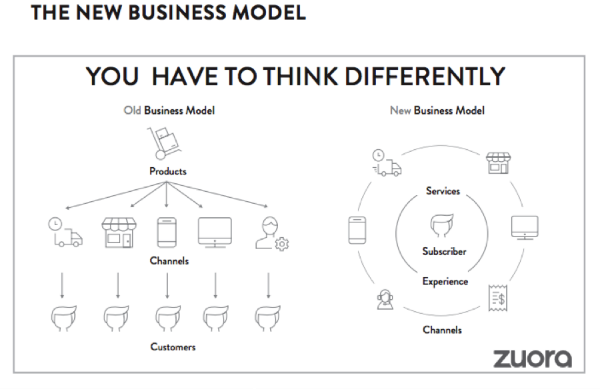The following excerpt from “Subscribed: Why the Subscription Model Will Be Your Company’s Future—and What to Do About It” by Tien Tzuo appears with permission from Portfolio, an imprint of Penguin Publishing Group, a division of Penguin Random House LLC. Copyright © Tien Tzuo, 2018.
 Today the glory days of the soulless, all-powerful corporation are long gone. Today’s customers are more informed by an order of magnitude. Most of them have researched, assessed, and categorized you before you can even say hello. And to most of them, especially younger ones, ownership just isn’t that important anymore. People increasingly view the prospect of buying something as unnecessary baggage. They want media at their fingertips, not physical products to manage. That’s why most of the big box retailers I grew up with are gone now: Circuit City, Tower Records, Blockbuster, Borders, Virgin Megastore. A lot of the malls are gone, too! Today people expect services to provide immediate, ongoing fulfillment, from rideshares to streaming services to subscription boxes. They want to be happily surprised on a regular basis. And if you don’t meet those expectations, you get dropped, not to mention trashed on social media. It’s that simple.
Today the glory days of the soulless, all-powerful corporation are long gone. Today’s customers are more informed by an order of magnitude. Most of them have researched, assessed, and categorized you before you can even say hello. And to most of them, especially younger ones, ownership just isn’t that important anymore. People increasingly view the prospect of buying something as unnecessary baggage. They want media at their fingertips, not physical products to manage. That’s why most of the big box retailers I grew up with are gone now: Circuit City, Tower Records, Blockbuster, Borders, Virgin Megastore. A lot of the malls are gone, too! Today people expect services to provide immediate, ongoing fulfillment, from rideshares to streaming services to subscription boxes. They want to be happily surprised on a regular basis. And if you don’t meet those expectations, you get dropped, not to mention trashed on social media. It’s that simple.
Forrester Research, which keeps tabs on roughly 85 percent of the global GDP, thinks we’re at the beginning of a new twenty-year business cycle they call “The Age of the Customer.” Forrester sees a broad, systemic shift in capital models pivoting toward serving a newly empowered generation of customers that have the ability to price, critique, and purchase anytime, anywhere. Here’s how Forrester describes the new customer mindset: “The expectation that any desired information or service is available, on any appropriate device, in context, at your moment of need.” Customers have new expectations (and yes, those expectations have certainly been driven by millennials, but at this point, almost everyone shares them). They want the ride, not the car. The milk, not the cow. The new Kanye music, not the new Kanye record.
Initially, the corporate world responded to this shift in pretty typical fashion—they built more systems. They spun up customer relationship management (CRM) databases, installed customer loyalty programs, offered membership rewards and incentives, and showered people with customer satisfaction surveys. It was a truth universally acknowledged that new customers were harder to acquire than loyal ones, and negative customer experiences traveled much farther than positive ones. There was a lot of talk about customer journeys and net promoter scores.
No one knows who coined the phrase “the customer is always right,” but it dates to the late-nineteenth-century department-store pioneers like Harry Gordon Selfridge and Marshall Field. It was a novel concept at the time (displacing a prevailing general retail attitude of caveat emptor), but what’s amazing is how all these big Fortune 500 companies still couldn’t get it right. They developed a lot of prescriptive strategies built around customer focus, but they lacked a descriptive understanding of the mindset of the customer herself. Large companies were still getting blown up on social media left and right, and there were certainly no sweeping changes in public sentiment toward big enterprises. It just wasn’t enough.
And then a funny thing happened—those digital disrupters like Salesforce and Amazon that I mentioned earlier took the whole customer-first concept a huge step further by actually establishing direct ongoing relationships with their customers. They didn’t have customer segments anymore—they had individual subscribers. And every one of those individual subscribers had their own home page, their own activity history, their own red flags, their own algorithmically derived suggestions, their own unique experiences. And thanks to subscriber IDs, all the boring transactional point-of-sale processes disappeared. Ten years ago there was no Spotify, and Netflix was a DVD company. Today both those companies own a significant percentage of the total revenue of their respective industries! Today businesses are asking themselves a whole new set of questions: What do we need to do to build long-term relationships? What do we need to do to focus on outcomes and not ownership? To invent new business models? To grow our recurring revenue, and to deliver ongoing value?
So again—what does digital transformation look like? I think it looks a lot like a circle. Let me explain.
If you remember one thing about this book, remember this diagram. It summarizes the shift underway. On the left side, you have the old model, where companies used to focus on “getting a product to market” and selling as many units of that product as possible: more cars, more pens, more razors, more laptops. They did this by getting their products into as many sales and distribution channels as possible. Of course, there must be a customer on the other end buying all this stuff, but often you didn’t really care who they were, as long as more units flew off the shelves.
That’s not how the modern company thinks. Today successful companies start with the customer. They recognize that customers spend their time across many channels, and wherever those customers are, that’s where they should be meeting their customers’ needs. And the more information you can learn about the customer, the better you can serve their needs, and the more valuable the relationship becomes. That’s digital transformation: from linear transactional channels to a circular, dynamic relationship with your subscriber.
Tien Tzuo is CEO of Zuora. The above excerpt from “Subscribed: Why the Subscription Model Will Be Your Company’s Future—and What to Do About It” by Tien Tzuo appears with permission from Portfolio, an imprint of Penguin Publishing Group, a division of Penguin Random House LLC. Copyright © Tien Tzuo, 2018.

